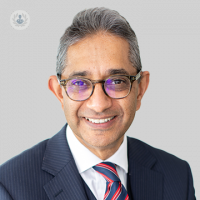Mouth cancer surgery: what to expect
Written in association with:Mouth cancer is a complicated form of surgery which involves a highly visible part of your body. Yet with the help of modern scanning technology and advances in surgical planning, we are now able to remove tumours and reconstruct the face in the same operation. We asked leading maxillofacial and oral surgeon Mr Bhavin G Visavadia what to expect from mouth cancer surgery:

Mouth cancer usually presents as a growth or an ulcer – typically affecting the tongue or floor of the mouth, the jaw or part of the cheek. Once mouth cancer has been diagnosed, the primary form of treatment is surgery. This tends to be supplemented by radiotherapy, and sometimes chemotherapy.
Given the nature of mouth cancer tumours and where they are located, surgery tends to proceed in three stages:
- complete removal of the tumour
- addressing any nearby lymph nodes
- reconstruction
Surgery is almost always the first choice when treating a cancer of the mouth. It's my opportunity to examine the cancer in three dimensions and also to take out the tissue, plus a margin of normal tissue. So, if there's a cancer of the tongue presenting as an ulcer or growth, then I can accurately take a centimetre of tissue all the way around the tumour and preserving the rest of the tissue for function and rehabilitation later on.
Removing the tumour
When removing the tumour, the type of surgery we perform is guided by the location and the size and the extent of the disease when it presents. What I would like to achieve is a good clear margin. For example, if the tumour is on the tongue, we can take a portion of the tongue out with a margin of a centimetre and preserve as much function as possible. If the cancer involves the jaw, then a significant portion of the jaw needs to be removed so that the bone can be looked at very carefully as for extent of disease.
All of this is planned in advance with the whole team, making use of scans as well as models.
Addressing lymph nodes
Once the cancer resection has been performed, we need to address the neck. Here, there are hundreds of lymph nodes which may be involved in the cancer fighting process.
The procedure is a function-preserving neck dissection. This involves making an incision in the neck and lifting the layers of tissues away so that we can then explore and dissect the lymph gland tissue away from all the structures in the neck. This is a meticulously performed procedure, preserving the nerves to the face and nerves to the shoulder as well as the major blood vessels.
The lymph nodes may be taken at the same time as the cancer operation. We call that “unblock” and the whole tissue can be then delivered to the pathologist intact for them to examine and perform their tests to see how extensive the cancer is.
Reconstruction
As you can imagine, the defect following cancer of the mouth, face or jaw can be quite significant. Usually, the surgeon would rebuild at the same time.
The surgery can be planned meticulously offline before we actually get to the operating theatre, and we often use scans and models and surgical stents to guide us to rebuild the face as it was before.
The tissue that we use to reconstruct the mouth, jaw or face can come from other parts of the body. A most common site is the forearm, where the soft pliable skin of the radio forearm can be used to reconstruct the tongue and the floor of the mouth. This allows the tongue that is preserved to function well and once this all heals; the speech and swallow functions are actually quite good.
If we need to reconstruct the jaw or part of the face, we need to have bone as well as soft tissue in order to be able to fill these defects. For those, we would approach either the leg or the hip. We can also use bone from the shoulder blade as well. The bone can be osteotomised or cut in a specific way to actually bend around the three-dimensional contours of the face.
The tissue is taken with its own blood supply and this is called a microvascular free flap. The blood vessels into and the vessels flowing out of are joined into blood vessels in the neck. This micro surgery is performed under great magnification, and we usually have a very high success rate for the flaps to function well immediately after they've been put in.
On the whole, mouth cancer treatment has really come a long way. With a dedicated team, careful planning and meticulous surgery, combined with advances in general anaesthesia and in critical care, we've significantly minimised the risks for such major surgery.


